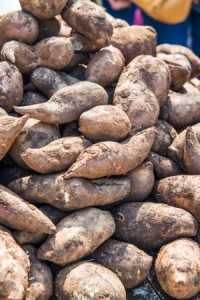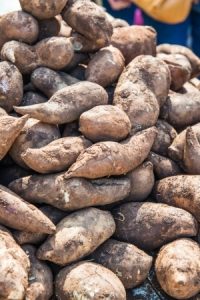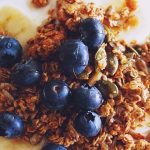
♦ Syrup from the root of a South American plant, the Yacon shows promise in weight management
♦ Sweetness of Yacon rivals that of stevia
Yacon (Smallanthus sonchifolius, family: Compositae) is a perennial tuberous plant that originated in the highlands of the Andes of South America. The roots have been eaten for centuries and resemble sweet potato in size, but have a taste a little like apples or pears. Andean farmworkers traditionally ate it during arduous labour in the fields and during religious festivals.
It is cultivated nowadays throughout Asia, Oceania and even in Europe, especially the Czech Republic and Slovakia. The main growing centres are Japan and South Korea (Ojansivu et al., 2011).

A very sweet fructo-oligosaccharide syrup resembling molasses is produced from these tubers. This syrup is now finding use as a natural sweetener ! The sugars in Yacon form upto 40 to 70% of the dry matter and are mainly composed of fructose (350 mg/g), glucose (160 mg/g), sucrose (75 mg/g), the fructooligosaccharides (FOS) – some of which are up to 10 fructan units, and small amounts of inulin and starch. It is estimated the oligofructans with a degree of polymerisation of 4 account for up to 67% of the dry matter at harvest. There is potential here for a natural sweetener to rival Stevia. The antioxidants found in Yacon, include chlorogenic acid and some caffeic acid such as 3,5-dicaffeoylquinic acid.
The FOS component is now used as a sweetener in its own right and is relatively low in calories. Additionally, the roots are said to have beneficial effects in managing obesity and type II diabetes by providing insulin resistance in humans (Genta et al., 2009). The ingested roots also have a laxative effect (Chen et al., 2009) and are claimed to reduce blood glucose and cholesterol levels in patients with metabolic syndrome and diabetes mellitus (Expert Panel, 2001;Valentova et al., 2004). It was reported that upon daily intake of the syrup which contained about 0.14g fructan sugars/kg/day over three months helped improve satiety and hence reduce waist size and obesity (Genta et al., 2009). There is evidence that these sugars help manipulate various satiety peptides such as the ghrelins (Parnell and Reimer, 2009). Whether the effect was due to the fructo-oligosaccharides or some other component needs to be identified. The syrup might be used successfully in the development of beverages, but a careful combination of flavours is required as the syrup retains some estery notes. FOS is a also a prebiotic which suggests yacon syrup might be successful in yoghurt type products promoting their probiota.
The tubers are eaten in the Andes, Japan and New Zealand. To be used in the EU, the syrup would require novel foods approval. Current growth is expected in terms of usage with dollar sales reaching 30% more than last year although that figures remains to be verified. The author is interested to know more about this syrup because of the potential prebiotic association and has some thoughts on how it might be used successfully in beverages and with Stevia sweeteners.
Please note this article contains links to our affiliate marketing partner. Please read our affiliate disclosure.
References
Chen., H-L, Lu, Y-H, Lin, J., Jr, Ko, L-Y. (2000) Effects of fructooligosaccharide on bowel function and indicators of nutritional status in constipated elderly men. Nutr. Res. 20 pp. 1725–1733.
Expert Panel on Detection, Evaluation, and Treatment of High Blood Cholesterol in Adults. Executive Summary of The Third Report of The National Cholesterol Education Program (NCEP) Expert Panel on Detection, Evaluation, And Treatment of High Blood Cholesterol In Adults (Adult Treatment Panel III) (2001) JAMA. 285 pp. 2486–2497.
Genta, S., Cabrera, W., Habib, N., Pons, J., Carillo, I.M., Grau, A., Sánchez S. (2009) Yacon syrup: beneficial effects on obesity and insulin resistance in humans. Clin Nutr. 28 pp. 182–187.
Ojansivu, I., Ferreira, C.L., Salminen, S. (2011) Yacon, a new source of prebiotic oligosaccharides with a history of safe use. Trends Food Sci. Tech. 22 pp. 40–6.
Parnell, J.A., Reimer, R.A. (2009) Weight loss during oligofructose supplementation is associated with decreased ghrelin and increased peptide YY in overweight and obese adults. Am. J. Clin. Nutr. 89 pp. 1751–9.
Valentová, K., Moncion, A., de Waziers, I., Ulrichová, J. (2004) The effect of Smallanthus sonchifolius leaf extracts on rat hepatic metabolism. Cell Biol. Toxicol. 20 pp. 109–120.


Candida feeds on sugar, replace your current sugars with things like stevia and yacon root syrup.
Bear in mind though there are people who have healed themselves of yeast infections.
Carob powder is also made by grinding seed pods ‘ this time, the pods from the carob
tree (Ceratonia siliqua).
My web-site :: Pure Yacon Syrup Diet
Yacon syrup is definitely the way to sweeten your desserts and adds a quality which you just do not find with other sweeteners. I think it beats Stevia anyday. Really glad you wrote about this sweetener.